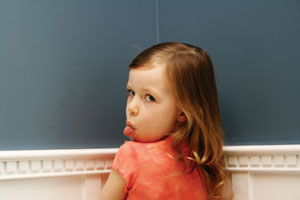“I think that doll is on a toy vacation,” 4-year-old Rosie says. Translation: She’s not allowed to play with it. Her mother, Sara Cole of Columbia City, explains, “I think a lot about positive discipline isn’t what you do, it’s how you do it.” For example, when Rosie disturbs her brother’s game, Cole picks her up and sits with her. “I could make her stay with me and it can be a punishment — like telling her, ‘You were being mean to your brother, so you need to stay with me,’” Cole says. But instead, she flips that message on its head, preferring a more positive spin: ‘I can see this is too hard for you right now, so I am supporting you by removing you from this situation.’”
Why not punish?
But isn’t punishment and discipline a good way to teach kids a lesson? Not so, according to Alfie Kohn, author of Unconditional Parenting and a host of other books on discipline and education. “To punish or discipline a child is to deliberately make a child feel bad in the hopes that this will have a positive result,” says Kohn. “But all that punishment can ever buy you is temporary compliance, and at a very high cost. The real lesson it teaches is about power: Those with more of it can coerce those with less of it to do whatever they demand. It makes kids more self-centered, less concerned about the impact of their actions on others. . . . No wonder we have to discipline a child over and over: The problem isn’t with the child; it’s with the whole idea of punishment.”
Instead, Kohn argues that parents should use neither punishments nor rewards. “The use of punishments and rewards exemplifies doing things to kids to make them obey. But the only way to help them grow into good people is to work with them — to explain, to guide, to listen, to solve problems together, to give them more chances to choose,” says Kohn.
Spanking
Many parents believe that spanking and time-outs are the only discipline choices we have. While spanking has fallen out of favor, it is still a common discipline practice. Some studies find that as many as 90 percent of parents spank their young children for discipline, yet researchers agree that spanking is an undesirable discipline strategy.
Spanking is also ineffective discipline, according to Elizabeth Pantley, author of The No-Cry Discipline Solution. “Hitting a child typically immediately stops a behavior because of shock, fear or pain. But most children turn around and repeat the same behavior — sometimes even the same day!” More importantly, Pantley says, “Spanking does nothing to teach a child to develop inner discipline. A child’s focus is on the spanking itself, not on a review of the behavior that led to it.”
According to Pantley, spanking teaches children who are frustrated and don’t know how to handle a problem that the solution is to hit someone. For parents of preschoolers who try to prevent their children from hitting, this can be a confusing message.
Both Pantley and Kohn agree that the most important reason to avoid spanking is because spanking gets in the way of a healthy parent-child relationship. “Children look up to their parents as protectors, teachers and guides,” says Pantley. “When a parent breaks that pattern by hitting a child, the relationship suffers.”
T ime-out
ime-out
The best known alternative to spanking is the “time-out.” But don’t get too comfortable with that option of discipline, experts say. “We know there is no more wounding experience to a child than punitive separation from a beloved caregiver,” says Gordon Neufeld, Ph.D., clinical psychologist, expert on child development and author of Hold On to Your Kids. Neufeld’s expert opinion is that time-outs are both ineffective and damaging.
Kids who are put into time-out might try various defenses, according to Neufeld. One is to numb vulnerable feelings, which interferes with the child developing a deep, vulnerable attachment with the parents. Without this attachment, the child’s inherent motivation to behave well diminishes . . . and leads to more time-outs. “It’s a vicious cycle,” says Neufeld. “Secure attachment is the single most important factor in healthy personality development.”
So, if parents should avoid both spanking and time-outs, what tools are left to help them manage their children’s behavior? “The answer is simple,” says Neufeld. “If life has to stop because a problem must be addressed, make sure that contact is increased rather than decreased. Problems are not solved by separation.” Neufeld suggests the use of a “time-in” with the child, taking the child out of the troublesome situation, but going along with her rather than separating.
Positive intent
Becky Bailey, Ph.D., developer of the Conscious Discipline program, also guides parents in gentle discipline. The tools she suggests are specific and detailed, such as “attributing positive intent.” Rather than saying, “You were being mean when you hit your brother when he was reading,” the parent should make the best possible assumption about the child’s intentions and reflect: “You wanted the book and didn’t know the words to use to ask for it.”
“When we attribute positive intent to discipline, we do three things,” says Bailey. “We keep ourselves calm so we can respond, instead of react, to the situation; we label the core of the child as ‘good’ and the behavior is what needs to change; and we teach our children life skills, because they are willing to listen instead of guard against being attacked.”
Cole uses these discipline techniques with Rosie regularly. “Sometimes, especially when Rosie is causing a conflict, I will just pick her up and move her to where I am. I tell her, ‘I see you are having trouble controlling your body right now, so I will help you do it.’ Then I engage her in something else.” This is hard for some adults to understand, according to Cole. “They think that the kids are manipulating us,” she says, “but often they think we are missing the underlying dynamic of the situation. In reality, we just see it differently than they do.”
As a mother of three small children, Tera Schreiber appreciates learning about new tools for discipline and admires parents who are able to use those tools with compassion and skill.
Originally published in the June, 2008 print edition of ParentMap.











